Papaver rhoeas
| Papaver rhoeas | |
|---|---|
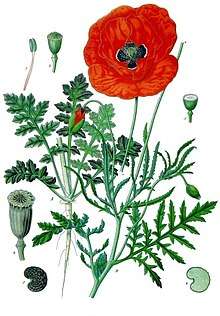 | |
| Scientific classification | |
| Kingdom: | Plantae |
| Clade: | Angiosperms |
| Clade: | Eudicots |
| Order: | Ranunculales |
| Family: | Papaveraceae |
| Genus: | Papaver |
| Species: | P. rhoeas |
| Binomial name | |
| Papaver rhoeas | |
| Synonyms[2] | |
| |
Papaver rhoeas (common names include common poppy,[3] corn poppy, corn rose, field poppy,[4] Flanders poppy or red poppy) is an annual herbaceous species of flowering plant in the poppy family, Papaveraceae. This poppy is notable as an agricultural weed (hence the common names including "corn" and "field") and after World War I as a symbol of dead soldiers.
Before the advent of herbicides, P. rhoeas sometimes was abundant in agricultural fields. Although the corn poppy (and its cultivars such as the Shirley poppy) and the California poppy are widely grown in gardens, only Papaver somniferum, the opium poppy, has significant farm production.
Description
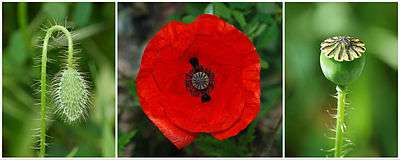
Papaver rhoeas is a variable, erect annual, forming a long-lived soil seed bank that can germinate when the soil is disturbed. In the northern hemisphere it generally flowers in late spring, (between May and October in the UK,[4]) but if the weather is warm enough other flowers frequently appear at the beginning of autumn. It grows up to about 70 cm in height. The stems hold single flowers,[4][5] which are large and showy, 50 to 100mm across,[6]:32 with four petals that are vivid red, most commonly with a black spot at their base. The petals slightly overlap each other.[4] The plant can produce up to 400 flowers in a warm season, despite the flowers only lasting one day.[4] The flower stem is usually covered with coarse hairs that are held at right angles to the surface, helping to distinguish it from Papaver dubium in which the hairs are more usually appressed (i.e. held close to the stem). The capsules are hairless, obovoid (egg-shaped), less than twice as tall as they are wide, with a stigma at least as wide as the capsule. Like many other species of Papaver, the plant exudes white to yellowish latex when the tissues are broken.[7]:88
Not all corn poppies that are available commercially have red flowers. Selective breeding has resulted in cultivars in yellow, orange, pink, and white. The Shirley Poppy is the most known cultivar. A very pale speckled variety, derived from the Shirley, is also available.
A nearly black-flowering hybrid, known as Evelina, was bred in Italy in the late 1990s, with Papaver dubium, but does not appear to be available commercially.[8]
Phytochemistry
Papaver rhoeas contains the alkaloid called rhoeadine which is a mild sedative.[9]
Taxonomy
It was formerly described by the Swedish botanist Carl Linnaeus in his seminal publication Species Plantarum in 1753.[2][10] Papaver, also ‘pappa’, is the Latin word for food or milk and 'rhoeas' means red in Greek.[9]
Distribution and habitat
Papaver rhoeas is a temperate native with a very wide area, from Africa, to temperate and tropical Asia and Europe.[9][5][11]
Range
It is found within Africa, in Algeria, Egypt, Libya, Morocco, Tunisia, Madeira Islands and Canary Islands.[11] Within temperate Asia, it is found in the Caucasus regions of Armenia, Azerbaijan, Georgia and Ciscaucasia. In the Western Asia regions, it is found in Afghanistan, Cyprus, Egypt, Iran, Iraq, Israel, Jordan, Lebanon, Syria and Turkey. Within tropical Asia, it is found in Pakistan. Within Europe, it is found in (Eastern Europe); Belarus, Latvia, Lithuania, Moldova, Ukraine, (Middle Europe); Austria, Belgium, Czech Republic, Germany, Hungary, Netherlands, Poland, Slovakia, Switzerland, (Northern Europe); Denmark, Ireland, Norway, Sweden, United Kingdom, (Southeastern Europe); Albania, Bosnia and Herzegovina, Bulgaria, Croatia, Greece, Italy, Macedonia, Montenegro, Romania, Serbia, Slovenia, (Southwestern Europe); France, Portugal and Spain.[11]
Habitat
It grows in fields, beside roads and grasslands.[4] It is hardy to between USDA Zone 8 and Zone 10, or between 10 °F (-12 °C).[5]
Natural history
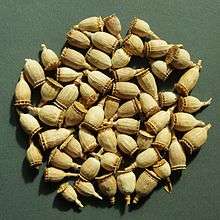
Its origin is not known for certain. As with many such plants, the area of origin is often ascribed by Americans to Europe, and by northern Europeans to southern Europe. It is known to have been associated with agriculture in the Old World since early times and has had an old symbolism and association with agricultural fertility. It has most of the characteristics of a successful weed of agriculture. These include an annual life cycle that fits into that of most cereals, a tolerance of simple weed control methods, the ability to flower and seed itself before the crop is harvested, and the ability to form a long-lived seed bank. The leaves and latex have an acrid taste and are mildly poisonous to grazing animals.[12]
A sterile hybrid with Papaver dubium is known, P. x hungaricum, that is intermediate in all characters with P. rhoeas.[7]
Papaver rhoeas topped the list in a UK study of meadow pollen production, on a per flower basis, with its rate of 13.3 ± 2.8μl. The California poppy placed second with a rate of 8.3±1.1μl. The pollen production of Papaver rhoeas, on a per flower basis, was very high in comparison with the other plants tested, at almost triple the amount of the top-ranked perennial (a mallow). When sampled at the level of the entire capitulum, however, Papaver rhoeas was outranked by the ox-eye daisy, Leucanthemum vulgare, with its 15.9 ± 2μl measurement. It tied with Cosmos bipinnatus. Neither poppy produced a significant quantity of nectar, making their role in meadow ecology specific to pollen-gathering/consuming insects.[13] As poppies are not wind-pollinated, their pollen poses no allergy risk via inhalation.
Cultural usage
Due to the extent of ground disturbance in warfare during World War I, corn poppies bloomed in between the trench lines and no man's lands on the Western front. Poppies are a prominent feature of "In Flanders Fields" by Canadian Lieutenant Colonel John McCrae, one of the most frequently quoted English-language poems composed during the First World War. During the 20th century, the wearing of a poppy at and before Remembrance Day (sometimes known informally as Poppy Day) each year became an established custom in English-speaking western countries.[4] It is also used at some other dates in some countries, such as at appeals for Anzac Day in Australia and New Zealand.
This poppy appears on a number of postage stamps, coins, banknotes, and national flags, including:
- Two hundred lei (Romanian banknote)
- Canadian twenty-dollar note (2012) and Canadian ten-dollar note (2001)
- Some commemorative Canadian twenty-five cent coins in 2004 and 2008
- Great Britain commemorative stamps 2000-2009: 2007 Lest we forget - 90th anniversary of the Battle of the Somme
The common or corn poppy was voted the county flower of Essex and Norfolk in 2002 following a poll by the wild plant conservation charity Plantlife.[14]
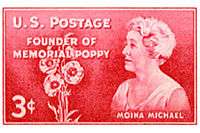 United States commemorative stamp depicting Moina Michael and corn poppies
United States commemorative stamp depicting Moina Michael and corn poppies- Claude Monet, "Summer Field of Coquelicots", 1875
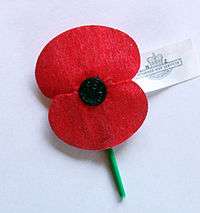
Persian literature
In Persian literature, red poppies, especially red corn poppy flowers, are considered the flower of love. They are often called the eternal lover flower. In classic and modern Persian poems, the poppy is a symbol of people who died for love (Persian: راه عشق).
Many poems interchange "poppy" and "tulip" (Persian: لاله).
[I] was asking the wind in the field of tulips during the sunrise: whose martyrs are these bloody shrouded?
[The wind] replied: Hafez, you and I are not capable of this secret, sing about red wine and sweet lips.
Urdu literature
In Urdu literature, red poppies, or "Gul-e-Lalah", are often a symbol of martyrdom, and sometimes of love.
Uses
The commonly grown garden decorative Shirley Poppy is a cultivar of this plant.[4]
The black seeds are edible, and can be eaten either on their own or as an ingredient in bread. Oil made from the seed is highly regarded in France.[9]
The petals contain a red dye which is used in some medicines and wines, also the dried petals are occasionally used to give colour to potpourris.[9]
It was also used in folk medicine, as a cure for gout, various aches and pains. The petals were used to create a syrup that was fed to children to help them sleep.[4]
See also
References
- ↑ Linné, Carl von (1753). Species Plantarum. Stockholm: Laurentius Salvius. p. 507.
- 1 2 "Papaver rhoeas L. is an accepted name". 23 March 2012. theplantlist.org. Retrieved 24 October 2017.
- ↑ "BSBI List 2007". Botanical Society of Britain and Ireland. Archived from the original (xls) on 2015-01-25. Retrieved 2014-10-17.
- 1 2 3 4 5 6 7 8 9 Reader's Digest Field Guide to the Wild Flowers of Britain. Reader's Digest. 1981. p. 30. ISBN 9780276002175.
- 1 2 3 Philips, Roger; Rix, Brian (1996). Perfect Plants. London: Macmillan. p. 298. ISBN 0333653416.
- ↑ Blamey, M.; Fitter, R.; Fitter, A (2003). Wild flowers of Britain and Ireland: The Complete Guide to the British and Irish Flora. London: A & C Black. ISBN 978-1408179505.
- 1 2 Stace, C. A. (2010). New Flora of the British Isles (Third ed.). Cambridge, U.K.: Cambridge University Press. ISBN 9780521707725.
- ↑ Sagrati, Giorgio (2012). "Evelina, the black poppy". The black poppy Evelina. WordPress. Retrieved 23 December 2017.
- 1 2 3 4 5 "Papaver rhoeas (common poppy)". kew.org. Retrieved 24 January 2017.
- ↑ "Papaveraceae Papaver rhoeas L." ipni.org. Retrieved 24 October 2017.
- 1 2 3 "Taxon: Papaver rhoeas L." npgsweb.ars-grin.gov. 14 November 2001. Retrieved 24 October 2017.
- ↑ "corn poppy (Common name)". cbif.gc.ca. 5 June 2013. Retrieved 24 October 2017.
- ↑ Hicks, DM; Ouvrard, P; Baldock, KCR (2016). "Food for Pollinators: Quantifying the Nectar and Pollen Resources of Urban Flower Meadows". PLoS ONE. 11 (6): e0158117. Bibcode:2016PLoSO..1158117H. doi:10.1371/journal.pone.0158117. PMID 27341588.
- ↑ "County Flowers | Wild plants". Plantlife. Archived from the original on 2015-04-30. Retrieved 2012-03-21.
External links
| Wikimedia Commons has media related to Papaver rhoeas. |
| Wikispecies has information related to Papaver rhoeas |